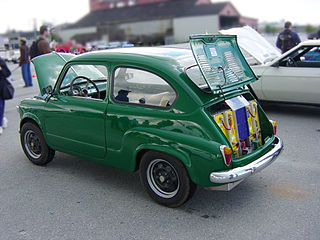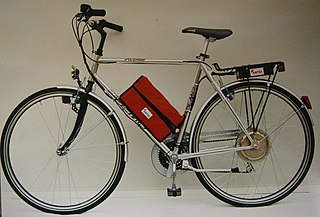Related Research Articles

Drag racing is a type of motor racing in which automobiles or motorcycles compete, usually two at a time, to be first to cross a set finish line. The race follows a short, straight course from a standing start over a measured distance, most commonly 1⁄4 mi, with a shorter, 1,000 ft distance becoming increasingly popular, as it has become the standard for Top Fuel dragsters and Funny Cars, where some major bracket races and other sanctioning bodies have adopted it as the standard. The 1⁄8 mi is also popular in some circles. Electronic timing and speed sensing systems have been used to record race results since the 1960s.
Power-to-weight ratio is a calculation commonly applied to engines and mobile power sources to enable the comparison of one unit or design to another. Power-to-weight ratio is a measurement of actual performance of any engine or power source. It is also used as a measurement of performance of a vehicle as a whole, with the engine's power output being divided by the weight of the vehicle, to give a metric that is independent of the vehicle's size. Power-to-weight is often quoted by manufacturers at the peak value, but the actual value may vary in use and variations will affect performance.
The National Electric Drag Racing Association (NEDRA) is a Special Chapter of the Electric Auto Association and exists to increase public awareness of electric vehicle (EV) performance. NEDRA also works to encourage competition and advances in electric vehicle technology. NEDRA achieves this by organizing and sanctioning safe, silent, and exciting electric vehicle drag racing events. The business is based out of Houston, TX.

In automobile engineering, electric vehicle conversion is the replacement of a car's combustion engine and connected components with an electric motor and batteries, to create a battery electric vehicle (BEV).

The Commuter Cars Tango is a prototype ultra-narrow electric sports car designed and built by Commuter Cars, an electric car company based in Spokane, Washington.

An electric bicycle is a motorized bicycle with an integrated electric motor used to assist propulsion. Many kinds of e-bikes are available worldwide, but they generally fall into two broad categories: bikes that assist the rider's pedal-power and bikes that add a throttle, integrating moped-style functionality. Both retain the ability to be pedaled by the rider and are therefore not electric motorcycles. E-bikes use rechargeable batteries and typically are motor-powered up to 25 to 32 km/h. High-powered varieties can often travel more than 45 km/h (28 mph).

An electric aircraft is an aircraft powered by electricity. Electric aircraft are seen as a way to reduce the environmental effects of aviation, providing zero emissions and quieter flights. Electricity may be supplied by a variety of methods, the most common being batteries. Most have electric motors driving propellers or turbines.

Electric motorcycles and scooters are plug-in electric vehicles with two or three wheels. Power is supplied by a rechargeable battery that drives one or more electric motors. Electric scooters are distinguished from motorcycles by having a step-through frame, instead of being straddled. Electric bicycles are similar vehicles, distinguished by retaining the ability to be propelled by the rider pedaling in addition to battery propulsion.

A pedelec or EPAC, is a type of low-powered electric bicycle where the rider's pedalling is assisted by a small electric motor. However, unlike some other types of e-bikes, pedelecs are classified as conventional bicycles in many countries by road authorities rather than as a type of electric moped. Pedelecs include an electronic controller which cuts power to the motor when the rider is not pedalling or when a certain speed – usually 25 km/h (16 mph) or 32 km/h (20 mph) – is reached. Pedelecs are useful for people who ride in hilly areas or in strong headwinds. While a pedelec can be any type of bicycle, a pedelec city bike is very common. A conventional bicycle can be converted to a pedelec with the addition of the necessary parts, e.g., motor, battery, etc.
The KillaCycle is an electrically powered motorcycle purpose-built for drag racing. It was built and is managed by a small motorworks team owned and run by Bill Dubé. For ten years until December 2010 it was the fastest electric motorcycle in the world.
Solar car racing refers to competitive races of electric vehicles which are powered by solar energy obtained from solar panels on the surface of the car. The first solar car race was the Tour de Sol in 1985 which led to several similar races in Europe, US and Australia. Such challenges are often entered by universities to develop their students' engineering and technological skills, but many business corporations have entered competitions in the past. A small number of high school teams participate in solar car races designed exclusively for high school students.

Artega Automobil GmbH & Co. KG is a German sports car manufacturer based in Delbrück, Germany. Founded by Klaus Dieter Frers in 2006, the company's first product was a mid-engined sports coupé released in 2007. In early 2010, a private equity and venture capital firm that already held a stake in Artega took full control. Artega filed for bankruptcy in July 2012. It was reacquired by a company under Frers' control that same year and eventually resumed production, specializing in electric vehicles.
An electric dragster is a drag racing vehicle which contains an electric propulsion system which is powered by batteries, fuel cells, supercapacitors (ultracapacitors), and sometimes they include a combustion engine to recharge their ESS.
Electric drag racing is a form of drag motor racing between electric vehicles.

Motorcycle testing and measurement includes a range of more than two dozen statistics giving the specifications of the motorcycle, and the actual performance, expressed by such things as the output of the engine, and the top speed or acceleration of the motorcycle. Most parameters are uncontroversial and claims made by manufacturers are generally accepted without verification. These might include simple measurements like rake, trail, or wheelbase, or basic features, such as the type of brakes or ignition system.

The Ford Fairlane Thunderbolt is a limited production, factory experimental, drag racing version of the Ford Fairlane produced during the 1964 model year only. A total of 100 units were produced; forty-nine 4-speeds and fifty-one automatics, enough to secure the 1964 NHRA Super Stock championship for Ford.

The Sikorsky Firefly is an all-electric helicopter built for research purposes by Sikorsky Aircraft. It has been called the world's "first all-electric helicopter". The Firefly is a modified Sikorsky S-300C helicopter with its engine replaced by an electric motor and two lithium-ion battery packs. The helicopter can hold only the pilot, no passengers, and operate for 12 to 15 minutes. It has a top speed of 80 kn.

The Renault Eolab is a concept car plug-in hybrid designed by the French car manufacturer Renault. It was unveiled to the press in September 2014, prior to its formal unveiling at the Paris Motor Show.

The Nio EP9 is a battery-powered, two-seat sports car manufactured by RML group on behalf of Chinese electric car company Nio, not assisted by their Formula E racing division. The name EP9 stands for Electric Performance 9.

The Ferrari SF90 Stradale is a mid-engine PHEV sports car produced by the Italian automobile manufacturer Ferrari. The car shares its name with the SF90 Formula One car with SF90 standing for the 90th anniversary of the Scuderia Ferrari racing team and "Stradale" meaning "made for the road".
References
- ↑ Record Holders Nedra. Retrieved: 17 June 2010.